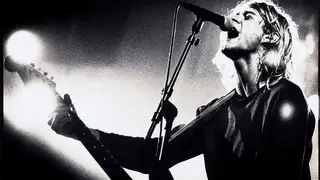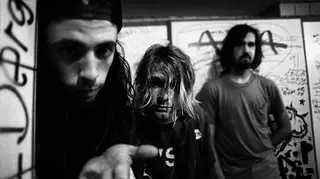The story behind Nirvana's "smiley face" logo - and its lawsuit
12 July 2024, 13:53 | Updated: 14 July 2024, 22:13

The classic t-shirt has been a popular design for 30 years, but where did the blank-eyed, zonked out smiley face actually come from? And why was it the subject of legal action?
Listen to this article
In September 1991, Nirvana - a fairly unknown grunge band from Seattle, Washington in the United States - suddenly became one of the biggest acts in the world, thanks to their million-selling second album, Nevermind.
For the next couple of years, the trio of Kurt Cobain, Krist Novoselic and Dave Grohl got bigger and bigger - and you couldn’t walk down the street in any big town without seeing one of these t-shirts.
Framed with a band logo in the “Onyx” typeface, the zonked out smiley appeared on the front, with the reverse bearing the slogan: "FLOWER SNIFFIN, KITTY PETTIN, BABY KISSIN CORPORATE ROCK WHORES"

However, since 2018, the famous t-shirt has been at the centre of a lawsuit between the band and fashion company Marc Jacobs, whose "Redux Grunge Collection" is alleged to have used some of the "smiley face" imagery - an accusation the fashion brand refuted. According to Billboard, the designer was inspired by "looks that his friends were wearing in downtown Manhattan and Pacific Northwest at the time".
However, the surviving members of the band - namely Dave Grohl, Krist Novoselic and Cobain's widow Courtney Love - claimed that Cobain had created the design himself, but the Jacobs camp maintained that Nirvana "lacked enforceable rights in the logo".

In 2020, designer Robert Fisher joined the case, claiming he created the "smiley face" logo for Nirvana back in the summer of 1991 when the band were looking for motifs to adorn the cover of their forthcoming second album Nevermind. Fisher claims that as art director for Geffen Records, he “started playing around with variations of the smiley faces that he used to draw in his final year at Otis College, when acid culture was at its peak."
It seems that as of July 2024, the case has been settled between all parties - although details have not been revealed as yet. According to Reuters: "The parties told the court,that they had accepted a mediator's proposals to resolve their dispute and would finalise settlement agreements within 21 days."
A US District Judge, John Kronstadt, had previously stated in 2023 that Geffen would have owned rights to the logo if Fisher made it while working for them, but the judge did not decide whether Cobain or Fisher had initially created the design.

When Fisher spoke about "acid culture", he meant the black and yellow smiley logo that had become popular in the 1970s, but was then subtly subverted by the acid house craze in the late 80s. In the hands of Nrvana, the image was obviously a comment on the inane, manufactured pop music that the trio and other grunge bands were kicking against.

According to Nirvana scholars, the image first made an appearance on a flyer announcing the launch party of the Nevermind album a the Re-Bar in Seattle on Friday 13th September 1991.
While the logo is attributed to Kurt Cobain, it’s long been thought that he was inspired by a similar googly-eyed face that appeared on the marquee of the notorious Seattle strip club, The Lusty Lady. The marquee was also regularly boast terrible puns based on the smutty activity taking place within.

Seattle XXX Shakespeare
Alongside the unforgettable image of a baby swimming after a dollar bill hooked onto a fishing line, the smiley logo was to become one of the enduring images of Nirvana’s short, but stellar career.









